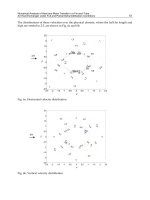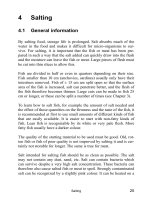Chapter 121. Intraabdominal Infections and Abscesses (Part 4) docx
Bạn đang xem bản rút gọn của tài liệu. Xem và tải ngay bản đầy đủ của tài liệu tại đây (42.88 KB, 5 trang )
Chapter 121. Intraabdominal
Infections and Abscesses
(Part 4)
Secondary Peritonitis: Treatment
Treatment for secondary peritonitis includes early administration of
antibiotics aimed particularly at aerobic gram-negative bacilli and anaerobes (see
below). Mild to moderate disease can be treated with many drugs covering these
organisms, including broad-spectrum penicillin/β-lactamase inhibitor
combinations (e.g., ticarcillin/clavulanate, 3.1 g q4–6h IV) or cefoxitin (2 g q4–6h
IV). Patients in intensive care units should receive imipenem (500 mg q6h IV),
meropenem (1 g q8h IV), or combinations of drugs, such as ampicillin plus
metronidazole plus ciprofloxacin. The role of enterococci and Candida spp. in
mixed infections is controversial. Secondary peritonitis usually requires both
surgical intervention to address the inciting process and antibiotics to treat early
bacteremia, to decrease the incidence of abscess formation and wound infection,
and to prevent distant spread of infection. While surgery is rarely indicated in PBP
in adults, it may be life-saving in secondary peritonitis.
Peritonitis may develop as a complication of abdominal surgeries. These
infections may be accompanied by localizing pain and/or nonlocalizing symptoms
such as fever, malaise, anorexia, and toxicity. As a nosocomial infection,
postoperative peritonitis may be associated with organisms such as staphylococci,
components of the gram-negative hospital microflora, and the microbes that cause
PBP and secondary peritonitis, as described above.
Peritonitis in Patients Undergoing CAPD
A third type of peritonitis arises in patients who are undergoing continuous
ambulatory peritoneal dialysis (CAPD). Unlike PBP and secondary peritonitis,
which are caused by endogenous bacteria, CAPD-associated peritonitis usually
involves skin organisms. The pathogenesis of infection is similar to that of
intravascular device–related infection, in which skin organisms migrate along the
catheter, which both serves as an entry point and exerts the effects of a foreign
body. Exit-site or tunnel infection may or may not accompany CAPD-associated
peritonitis. Like PBP, CAPD-associated peritonitis is usually caused by a single
organism. Peritonitis is, in fact, the most common reason for discontinuation of
CAPD. Improvements in equipment design, especially the Y-set connector, have
resulted in a decrease from one case of peritonitis per 9 months of CAPD to one
case per 15 months.
The clinical presentation of CAPD peritonitis resembles that of secondary
peritonitis in that diffuse pain and peritoneal signs are common. The dialysate is
usually cloudy and contains >100 WBCs/µL, >50% of which are neutrophils. The
most common organisms are Staphylococcus spp., which accounted for ~45% of
cases in one recent series. Historically, coagulase-negative staphylococcal species
were identified most commonly in these infections, but more recently these
isolates have been decreasing in frequency. Staphylococcus aureus is more often
involved among patients who are nasal carriers of the organism than among those
who are not, and this organism is the most common pathogen in overt exit-site
infections. Gram-negative bacilli and fungi such as Candida spp. are also found.
Vancomycin-resistant enterococci and vancomycin-intermediate S. aureus have
been reported to produce peritonitis in CAPD patients. The finding of more than
one organism in dialysate culture should prompt evaluation for secondary
peritonitis. As with PBP, culture of dialysate fluid in blood culture bottles
improves the yield. To facilitate diagnosis, several hundred milliliters of removed
dialysis fluid should be concentrated by centrifugation before culture.
CAPD Peritonitis: Treatment
Empirical therapy for CAPD peritonitis should be directed at S. aureus,
coagulase-negative Staphylococcus, and gram-negative bacilli until the results of
cultures are available. Guidelines issued in 2005 suggest that agents should be
chosen on the basis of local experience with resistant organisms. In some centers,
a first-generation cephalosporin such as cefazolin (for gram-positive bacteria) and
a fluoroquinolone or a third-generation cephalosporin such as ceftazidime (for
gram-negative bacteria) may be reasonable; in areas with high rates of infection
with methicillin-resistant S. aureus, vancomycin should be used instead of
cefazolin, and gram-negative coverage may need to be broadened. Broad coverage
including vancomycin should be particularly considered for toxic patients and for
those with exit-site infections. Loading doses are administered intraperitoneally;
doses depend on the dialysis method and the patient's renal function. Antibiotics
are given either continuously (i.e., with each exchange) or intermittently (i.e., once
daily, with the dose allowed to remain in the peritoneal cavity for at least 6 h). If
the patient is severely ill, IV antibiotics should be added at doses appropriate for
the patient's degree of renal failure. The clinical response to an empirical treatment
regimen should be rapid; if the patient has not responded after 48 h of treatment,
catheter removal should be considered.
Tuberculous Peritonitis
See Chap. 158.
Intraabdominal Abscesses









